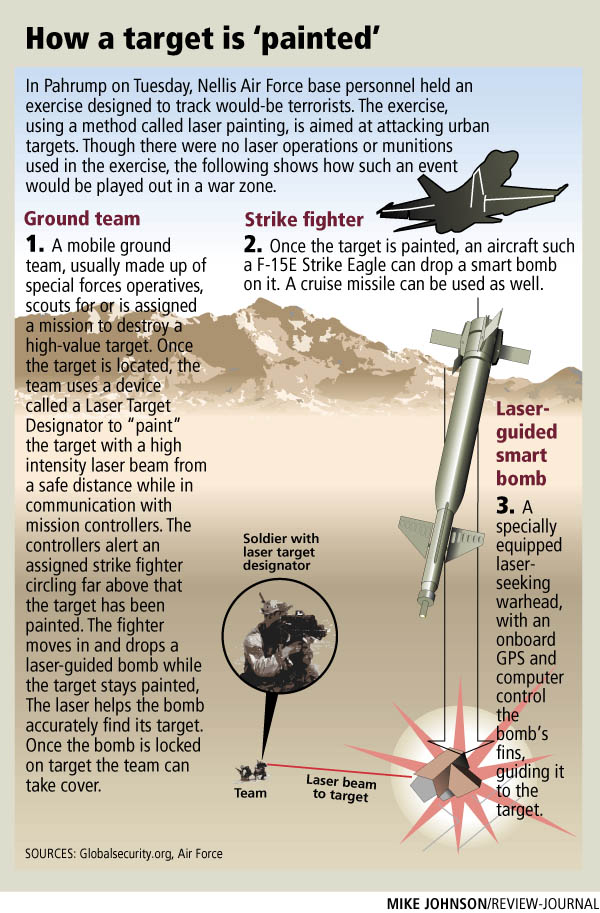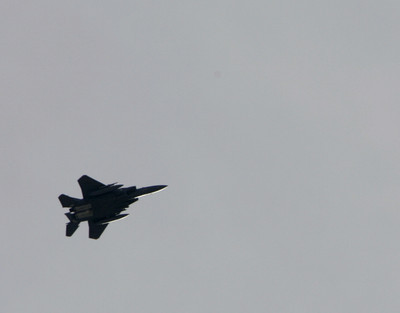Pahrump stands in for terrorist hunt
PAHRUMP -- For about an hour Tuesday, the distant roar from a pair of fighter jets circling high over this laid-back town could be heard above the rumble of trucks and cars rolling down state Route 160 and the streets that branch from its two stoplight intersections.
Unbeknownst to many of the 38,000 who live here, the Air Force had turned Nye County's largest community into a make-believe city in Iraq's war zone where would-be terrorists went through the motions of setting off bombs and fleeing in vehicles to its outskirts.
Was it supposed to be Baghdad? Baqouba? Maybe Mosul? Air Force officials wouldn't say.
What they did say, though, is that friendly forces patrolling the town in civilian clothes hoped to find the militants and call in a simulated airstrike from the orbiting F-15E Strike Eagles. The idea was to demonstrate that the bad guys could be killed without hitting the good guys.
It all began about 12:15 p.m. when the jets arrived from Nellis Air Force Base, flying more than 70 miles over the Las Vegas Valley and past the Spring Mountains.
"They told us exactly what they were going to do and as far as I know they lived up to that agreement," Nye County Commission Chairman Gary Hollis said outside the Ruud Community Center, where the commission's regularly scheduled meeting had commenced as the urban air support exercise was winding down.
He said the Air Force "wanted to make it as real life as possible."
"Terrorists don't wear uniforms and they don't carry flags," said Hollis, a 39-year resident of the town. "I support the U.S. Air Force and its endeavor to keep our community safe."
Ground troops, he said, were wearing civilian clothes and driving rented vehicles, contrary to a Nov. 14 Nellis press release that stated, "Ground teams will consist of approximately six personnel in three military vehicles with radio communication equipment in the town area. ... Ground personnel will not carry weapons and will be in military uniforms."
A Nellis spokeswoman did confirm, however, that flight operations were kept at a minimum 7,000 feet above ground level and the aircraft and ground crews didn't employ lasers or weapons. On the battlefield, however, lasers would be used to pinpoint the targets for the circling jets.
Nor did the planes carry ordnance Tuesday while flying over urban areas, the spokeswoman said about the exercise that's being conducted in phases through Thursday. Results on how successful it was won't be known until later.
A few blocks from the Ruud center, Carolyn Campbell said she noticed the commotion from the jets.
"You could just hear the planes going over my house. My dog was running around the yard. He knew something was going on," she said.
But Campbell didn't mind. She has a son in the Army and knows the importance of training exercises.
"If it's the closest thing they can come to it, I'm all for it," she said of the town's role. "I would think there would be other places that would be better."
How about the sprawling test and training range to the north and out of the public's view?
Hollis said there are no urban settings the size of Pahrump on the Air Force range that could mimic the conditions the training troops would be subject to overseas in a couple of weeks.
But unlike this spring when the Air Force conducted a similar exercise over the town and elsewhere without prior notification, this exercise was arranged through a pact approved by the commission.
Tommy Watson, an eight-year resident, said Tuesday's exercise was "fine with me. ... They're high enough, they're not impeding on what we're doing here."
But as for Pahrump doubling as an Iraqi city, "I don't particularly care for that," he said.
At the private Calvada airstrip four miles from the town's center, Phil Shallenberger said helicopters were supposed to deliver troops for the exercise.
Up the street, not far from Interceptor Drive and Helicopter Avenue, Charlie Wagner said he thought the troops would be dropped off, "then they'd do some lookin' for terrorists. I guess they think Pahrump looks like a town in Iraq."
Contact reporter Keith Rogers at krogers@reviewjournal.com or (702) 383-0308.



















